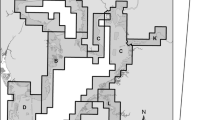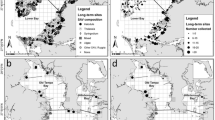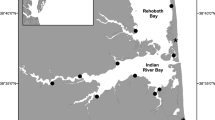Abstract
We examined relationships between freshwater inflow and population abundance and distribution of two size classes (15–50 mm Standard Length and 51–100 mm SL) of spotted seatrout (Cynoscion nebulosus) and red drum (Sciaenops ocellatus) over our 13-year study covering shallow waters of Tampa Bay and several adjacent rivers. Juveniles of seatrout were relatively abundant most years and broadly distributed primarily in the bay. Freshwater inflow was positively related to spatial distribution and abundance of smaller juveniles of seatrout, yet it was unrelated to the larger size class. Red drum juveniles were less abundant and narrowly distributed primarily within the rivers. Lower portions of the Alafia, Little Manatee, and Manatee Rivers—a combined area comprising only 2 % of the study area—contained 40–96 % of the annual population. Freshwater inflow was positively related to population distribution and abundance of larger red drum suggesting that reductions in inflow can reduce both habitat area and populations. Inflow was related to abundance but not distribution of the smaller red drum suggesting that inflow may increase habitat quality but perhaps not quantity at this earlier growth stage. Comparing spatial and population dynamics of multiple species can help prioritize them for conservation and management issues, such as freshwater inflow regulation. Reductions in inflow reduce populations and spatial distribution of at least one juvenile life stage of these two fishery species. Due to their narrow spatial distribution in the rivers, juveniles of red drum appear to be particularly vulnerable to modification of the riverine environment.



Similar content being viewed by others
References
Bacheler, N.M., L.M. Paramore, J.A. Buckel, and F.S. Scharf. 2008. Recruitment of juvenile red drum in North Carolina: spatiotemporal patterns of year-class strength and validation of a seine survey. North American Journal of Fisheries Management 28: 1086–1098.
Beck, M.W., K.L. Heck, K.W. Able, D.L. Childers, et al. 2001. The identification, conservation, and management of estuarine and marine nurseries for fish and invertebrates. BioScience 51: 633–641.
Cochran, W.G. 1977. Sampling techniques, 3rd ed. New York, USA: Wiley.
Crocker, P.A., C.R. Arnold, J.A. DeBoer, and G.J. Holt. 1983. Blood osmolality shift in juvenile red drum Sciaenops ocellatus L. exposed to fresh water. Journal of Fish Biology 23(3): 315–319.
Dorval, E., C.M. Jones, R. Hannigan, and J. van Montfrans. 2005. Can otolith chemistry be used for identifying essential seagrass habitats for juvenile spotted seatrout, Cynoscion nebulosus, in Chesapeake Bay? Marine and Freshwater Research 56(5): 645–653.
Estevez, E.D. 2002. Review and assessment of biotic variables and analytical methods used in estuarine inflow studies. Estuaries 25(6B): 1291–1303.
Flannery, M.S., E.B. Peebles, and R.T. Montgomery. 2002. Percent-of-flow approach for managing reductions of freshwater inflows from unimpounded rivers to southwest Florida estuaries. Estuaries 25(6B): 1318–1332.
Gillson, J. 2011. Freshwater flow and fisheries production in estuarine and coastal systems: where a drop of rain is not lost. Reviews in Fisheries Science 19(3): 168–186.
Greene, G., C.B. Moss, and T.H. Spreen. 1997. Demand for recreational fishing in Tampa Bay, Florida: a random utility approach. Marine Resource Economics 12: 293–305.
Greenwood, M.F.D., R.E. Matheson Jr., R.H. McMichael Jr., and T.C. MacDonald. 2007. Community structure of shoreline nekton in the estuarine portion of the Alafia river, Florida: differences along a salinity gradient and inflow-related changes. Estuarine, Coastal and Shelf Science 74(2): 223–238.
Jassby, A.D., W.J. Kimmerer, S.G. Monismith, C. Armor, J.E. Cloern, T.M. Powell, J.R. Schubel, and T.J. Vendlinski. 1995. Isohaline position as a habitat indicator for estuarine populations. Ecological Applications 5(1): 272–289.
Kimmerer, W.J. 2002a. Physical, biological, and management responses to variable freshwater flow into the San Francisco estuary. Estuaries 25(6B): 1275–1290.
Kimmerer, W.J., J.H. Cowan Jr., L.W. Miller, and K.A. Rose. 2001. Analysis of an estuarine striped bass population: effects of environmental conditions during early life. Estuaries 24(4): 557–575.
Le Pape, O., F. Chauvet, Y. Desaunay, and G. Guerault. 2003. Relationship between interannual variations of the river plume and the extent of nursery grounds for the common sole (Solea solea, L.) in Vilaine Bay. Effects on recruitment variability. Journal of Sea Research 50(2/3): 177–185.
McMichael, R.H., and K.M. Peters. 1989. Early life history of spotted seatrout, Cynoscion nebulosus (Pisces: Sciaenidae), in Tampa Bay, Florida. Estuaries 12(2): 98–110.
Murphy, M.D., and R.G. Taylor. 1990. Reproduction, growth, and mortality of red drum Sciaenops ocellatus in Florida waters. U.S. National Marine Fisheries Service Fishery Bulletin 88: 531–542.
Nelson, G.A., and D. Leffler. 2001. Abundance, spatial distribution, and mortality of young-of-the-year spotted seatrout (Cynoscion nebulosus) along the Gulf Coast of Florida. Gulf of Mexico Science 19(1): 30–42.
Peebles, E.B., and M.F.D. Greenwood. 2009. Spatial abundance quantiles as a tool for assessing habitat compression in motile estuarine organisms. Florida Scientist 72: 277–288.
Peters, K.M., and R.H. McMichael. 1987. Early life history of the red drum, Sciaenops ocellatus (Pisces: Sciaenidae), in Tampa Bay, Florida. Estuaries 10(2): 92–107.
Powell, G. L., J. Matsumoto, and D. A. Brock. 2002. Methods for determining minimum freshwater inflow needs of Texas bays and estuaries. Estuaries 25(6): 1262–1274.
Purtlebaugh, C.H., and M.S. Allen. 2010. Relative abundance, growth, and mortality of five age-0 estuarine fishes in relation to discharge of the Suwannee River, Florida. Transactions of the American Fisheries Society 139: 1233–1246.
Rakocinski, C.F., D.M. Baltz, and J.F. Fleeger. 1992. Correspondence between environmental gradients and the community structure of marsh-edge fishes in a Louisiana estuary. Marine Ecology Progress Series 80: 135–148.
Robins, J.B., I.A. Halliday, J. Stauton-Smith, D.G. Mayer, and M.J. Sellin. 2005. Freshwater-flow requirements of estuarine fisheries in tropical Australia: a review of the state of knowledge and application of a suggested approach. Marine and Freshwater Research 56: 343–360.
Saucier, M.H., and D.M. Baltz. 1993. Spawning site selection by spotted seatrout, Cynoscion nebulosus, and black drum, Pogonias cromis, in Louisiana. Environmental Biology of Fishes 36: 257–272.
Sogard, S.M. 1997. Size-selective mortality in the juvenile stage of teleost fishes: a review. Bulletin of Marine Science 60(3): 1129–1157.
Stevens, P.W., M.F.D. Greenwood, C.F. Idelberger, and D.A. Blewett. 2010. Mainstem and backwater fish assemblages in the tidal Caloosahatchee River: implications for freshwater inflow studies. Estuaries and Coasts 33(5): 1216–1224.
Stunz, G.W., T.J. Minello, and P.S. Levin. 2002. A comparison of early juvenile red drum densities among various habitat types in Galveston Bay, Texas. Estuaries 25(1): 76–85.
Thayer, G.W., A.B. Powell, and D.E. Hoss. 1999. Composition of larval, juvenile, and small adult fishes relative to changes in environmental conditions in Florida Bay. Estuaries 22: 518–533.
Walters, S., S. Lowerre-Barbieri, J. Bickford, and D. Mann. 2009. Using a passive acoustic survey to identify spotted seatrout spawning sites and associated habitat in Tampa Bay, Florida. Transactions of the American Fisheries Society, 138(1): 88–98.
Whaley, S.D., J.J. Burd Jr., and B.A. Robertson. 2007. Using estuarine landscape structure to model distribution patterns in nekton communities and in juveniles of fishery species. Marine Ecology Progress Series 330: 83–99.
Whaley, S.D., M. C. Christman, and J.J. Burd Jr. 2015. Spatial distribution-abundance relationships in juvenile (Age-0) red drum (Sciaenops ocellatus) and spotted seatrout (Cynoscion nebulosus). II: Influence of three major disturbances. Estuaries and Coasts, this issue.
Xian, G., and M. Crane. 2005. Assessments of urban growth in the Tampa Bay watershed using remote sensing data. Remote Sensing of the Environment 97: 203–215.
Zwick, P.D., and M.H. Carr. 2006. Florida 2060: a population distribution scenario for the State of Florida. Gainesville, FL: Geoplan Center, University of Florida. 25pp.
Acknowledgments
We are grateful to the Florida Fish and Wildlife Research Institute’s Fisheries Independent Monitoring program for collecting the field data used in this analysis. This sampling program is partially supported by the U.S. Fish and Wildlife Service (Sport Fish Restoration Grant F-43). In addition, we greatly appreciate support by senior staff (H. Norris, R. Flamm, and K. O’Keife) and the entire Center for Spatial Analysis team at FWRI (partially supported by the U.S. Fish and Wildlife Service, Sport Fish Restoration Grant F-66). This manuscript benefited from valuable comments from W. Cooper, M. Barrett, R. Butryn, C. Harmak, and several anonymous reviewers.
Author information
Authors and Affiliations
Corresponding author
Additional information
Communicated by Josianne G. Støttrup
Rights and permissions
About this article
Cite this article
Whaley, S.D., Christman, M.C. & Burd, J.J. Spatial Distribution–Abundance Relationships in Juvenile (Age 0) Red Drum (Sciaenops ocellatus) and Spotted Seatrout (Cynoscion nebulosus). I: Influence of Freshwater Inflow. Estuaries and Coasts 39, 742–751 (2016). https://doi.org/10.1007/s12237-015-0027-3
Received:
Revised:
Accepted:
Published:
Issue Date:
DOI: https://doi.org/10.1007/s12237-015-0027-3




